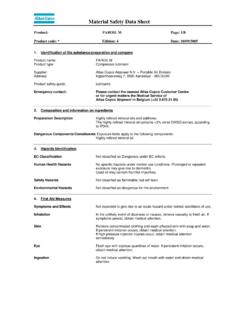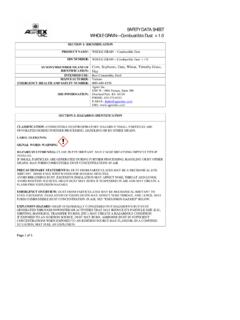Transcription of Tuberculosis - - RN.org®
1 Tuberculosis Reviewed September 2017, Expires September 2019 Provider Information and Specifics available on our Website Unauthorized Distribution Prohibited 2017 , , , LLC By Wanda Lockwood, RN, BA, MA Introduction Mycobacterium Tuberculosis , which causes Tuberculosis (TB), is a non-motile obligate aerobic bacillus (rod) that forms chains. M. Tuberculosis is neither Gram-negative nor Gram-positive. As an extracellular agent, M. Tuberculosis needs oxygen to live and multiply, so it is attracted to the upper respiratory tract. It is also a facultative intracellular invader, allowing it to evade the immune system. Humans serve as the only reservoir for M. Tuberculosis . M. Tuberculosis s virulence is increased because of components of its cell wall: Peptidoglycan: Prevents osmotic pressure from destroying the cell. Complex lipids: Provide antibiotic resistance. Acids: Protect the cell. Cord factor: Protects the cell from macrophages and causes toxic reaction in host s lipids (such as in the alveoli).
2 Wax-D: Protects the cell envelope. M. Tuberculosis is spread through airborne transmission. When an infected person talks, coughs, or sneezes, small infected particles (1 to 5 micrometers per diameter) enter the air. Larger droplets fall, but the small particles remain suspended in the air and can be inhaled by anyone who comes in contact with them. Primary pulmonary disease Wikimedia Commons, M. Haggstro Once inhaled, the bacilli travel through the airways to the lungs and the alveoli, where they begin to multiply. The bacilli invade the lymph symptom and can travel to other parts of the body, including the upper lobes of the lungs . The host s immune system attempts to control the spread of M. Tuberculosis by an inflammatory reaction in which some bacilli are engulfed by phagocytes (neutrophils and macrophages) and TB-specific lymphocytes destroy the bacilli, along with normal tissue. As cells are destroyed, exudate begins to accumulate in the alveoli and causes bronchopneumonia, usually within 2 to 10 weeks after initial exposure.
3 Latent TB If the host s immune system is adequate, the macrophages wall off the mass of live and dead bacilli, forming a granuloma and causing a positive skin reaction (cell-mediated immune response) but no active infection. This is latent TB. The walled-off granuloma is eventually transformed into fibrous tissue and the center becomes necrotic and cheesy. This center portion is called a Ghon tubercle. The cheesy mass may become calcified, and most of the bacilli die, but some become dormant People with latent TB have no symptoms and cannot spread the disease to others while the disease remains dormant. Chest x-rays and sputum tests are generally negative, but patients are at risk of active TB and need treatment to prevent TB disease. Active TB If the immune system is overwhelmed because of a large number of bacilli or a weak immune system, then the bacilli begin to multiply and to destroy tissue, resulting in active TB and sometimes causing a cavity to form in the lungs . Only about 10% of those with an initial infection develop active disease.
4 Additionally, dormant bacilli may also become reactivated, sometimes years after the initial infection. The reactivated bacilli activate immune cells to render host cells sensitive to killing and other immune cells to liquefy the cheesy material at the center of the Ghon tubercule, which erodes and releases the infected material into the airway, forming a cavity and allowing the bacilli to become airborne again and spread to others. Oxygen and carbon dioxide enter the cavity and bacilli begin to rapidly multiply and spread from the cavities through the air passages to other parts of the lungs and to the larynx. As the ruptured tubercle heals, it forms scar tissue and more inflammation, which in turn causes bronchopneumonia and the development of more tubercles. The process of damage to lung tissue spreads to the lung hilum and to adjacent lobes. PHIL, CDC In some cases, periods of remission varying in length may be followed by periods of reactivated disease. Reactivation TB often relates to an impaired immune system.
5 Immunity may be impaired in those with HIV, diabetes, transplants, cancer of the head or neck, Hodgkin s disease, leukemia, substance abuse, kidney disease and low body weight. Drugs that impair immunity include immunosuppressants, such as corticosteroids and chemotherapeutic agents. Elderly patients may have less obvious symptoms than children or younger adults. Symptoms of primary pulmonary TB Cough Persisting 3 weeks or longer. Non-productive or mucopurulent. Hemoptysis (may occur, especially as TB progresses). Fever Low grade. Chills. Night sweats Frequent. Pronounced (drenched with perspiration). General malaise Fatigue. Weight loss. Loss of appetite. Pain Chest pain. Pain when breathing or coughing. While TB has been in a decline in the United States, there has been an increase in the immigrant population with rates of infection among foreign-born residents almost 10 times higher than of native-born residents Nosocomial outbreaks have occurred, often related to failure to identify an infected source.
6 Resistant TB Resistant strains of TB are an increasing cause of concern. In rare cases, people with resistant TB strains have required forced hospitalization and isolation to protect the public: Multi-drug resistant Tuberculosis (MDR-TB) is resistant to at least 2 commonly used first-line drugs, isoniazid (INH) and rifampin. Extensively drug resistant Tuberculosis (XDR-TB) is also resistant to all fluoroquinolones and at least one of the three second-line drugs: amikacin, kanamycin, or capreomycin. XDR-TB emerged as a worldwide concern in 2005. In the United States, most XDR-TB is found in patients who are foreign born or immunocompromised (such as with HIV/AIDS). Active TB requires treatment for extended periods of time, usually 18-24 months, with multiple drugs, and some people cannot or will not comply with this regimen. Since the 1980s, resistance has caused an increased need for second-line drugs to combat infection. The primary causes for increased resistance include: Failure to complete a course of treatment Mismanaged treatment, including incorrect medication, dosage, or duration of therapy.
7 People who have had previous TB are at especially increased risk of developing resistant strains and should be monitored carefully. Drug resistant TB increasingly poses a risk for patients and staff in healthcare facility. Extrapulmonary Tuberculosis Wikimedia Commons, M. Haggstrom Extrapulmonary or disseminated Tuberculosis has spread from the lungs to other parts of the body through the circulatory system. It is also sometimes referred to as miliary TB. With this type of Tuberculosis , the lesions tend to be small (1 to 5 mm) and widely disseminated throughout the lungs . When a lesion erodes into the pulmonary vein, the bacilli are carried throughout the body. In the United States, primary pulmonary Tuberculosis is the most common, but about 1 to 3 percent goes on to develop disseminated Tuberculosis . Patients at increased risk are those who are immunocompromised, such as HIV/AIDS patients. In fact, about half of AIDS patients with CD4 counts <200 and co-infected with Tuberculosis develop the disseminated disease.
8 Infants and the elderly are also at increased risk because their immune systems are less effective. The onset of disseminated infection varies from weeks to years after initial infection. Since the initial infection begins in the lungs , symptoms at onset are the same as those of primary pulmonary Tuberculosis , but as the infection spreads, more symptoms become evident. Symptoms of extrapulmonary (disseminated) TB Organ Splenomegaly. Hepatomegaly. Anorexia and weight loss. Abdominal distention. Jaundice. Bone (spine most Back pain (most common). Compression fractures. common). Back deformity. Joint pain. Genitourinary Flank pain. Dysuria (frequency, nocturia). Pyuria. Hematuria. Urgency, incontinence. Pain in suprapubic area and/or costovertebral angle. Thickened epididymis. Urethral stricture. Scrotal/vesicovaginal fistula. Meningeal Fever. Nausea and vomiting. Nuchal rigidity. Loss of consciousness. Seizures. Severe headache. Photophobia. Neck (scrofula) Cervical lymph nodes (often bilateral) swollen and firm, hardening as disease progresses.
9 Fistula with drainage sometimes evident. Pleurisy (granuloma ruptures into pleural space) Marked increase of fluid in pleural space. Dyspnea. Mild to low-grade fever. Pleuritic pain on inspiration. Peritoneal Abdominal distention (ascites). Abdominal pain. Pericardial Fever. Dysrhythmia General malaise with poor appetite. Sharp piercing chest pain. Adrenal involvement Fever Nausea and vomiting. Abdominal pain. Weakness and general fatigue. Disorientation, confusion. Hypotensive shock. Dehydration. Electrolyte imbalance with hyperkalemia, hypercalcemia, hypoglycemia and hyponatremia. Bacille Calmette-Gu rin (BCG) Vaccine While a vaccine is available for TB, it is not routinely recommended for use in the United States. BCG (Bacille Calmette-Gu rin) is a Tuberculosis vaccine that is commonly administered to children in countries with high incidences of childhood tuberculous meningitis and disseminated TB. BCG has been used for about 80 years, but it has limitations. BCG has proven to be about 80% effective in preventing TB infection, but the results last only about 15 years, and effectiveness appears to vary according to the environment, so it is more effective in some parts of the world than in others.
10 BCG does not prevent primary infection or reactivation of latent pulmonary infection. BCG is not recommended in the United States because infection with Mycobacterium Tuberculosis has a low incidence, BCG is not always effective to prevent adult pulmonary TB, and adult immunization is variable. Further, BCG often results in false positives on skin testing, making subsequent diagnosis of TB more difficult. Immigrants or visitors from other countries may have been vaccinated as infants or children, so those showing positive skin testing should be questioned carefully about previous vaccination before treatment is prescribed since skin testing is not reliable for this population. Blood tests are more accurate and are less likely to render a false positive. Recommendations In the United States, BCG vaccine is recommended only for the following: Health care workers may receive BCG vaccinations if they work with a large number of TB patients with resistant strains of TB, there is ongoing transmission of this disease to healthcare workers, and TB control precautions are unsuccessful.















